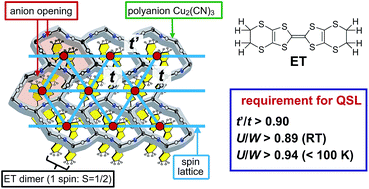Quantum spin liquid: design of a quantum spin liquid next to a superconducting state based on a dimer-type ET Mott insulator†
Abstract
The existence of a spin-disordered quantum state was predicted theoretically by Wannier in 1950 and Anderson in 1973. Various target materials had been considered before the discovery of the first quantum spin liquid (QSL) system in 2003: a Mott insulator κ-(ET)2Cu2(CN)3, where ET is bis(ethylenedithio)tetrathiafulvalene. The family of dimer-type ET conductors κ-(ET)2X (where X = an anion) exhibits various conduction profiles ranging from insulators to metals to superconductors depending on the counter anion. In κ-(ET)2X, the anion molecules form characteristic patterns of anion openings, on each of which an ET dimer corresponding to a single spin site is positioned, namely a key–keyhole relation. The topological consideration of the crystal structure affords the information on both a spin geometry (t′/t) and electron correlation (U/W), where t and t′ are interdimer transfer interactions with an isosceles triangular geometry, and U and W are the on-site Coulomb repulsion energy and bandwidth, respectively. The QSL system κ-(ET)2Cu2(CN)3 is characterized by a spin lattice containing nearly equilateral triangles (t′/t = 1.09) with strong electron correlations (U/W = 0.93) at room temperature. The temperature dependences of t′/t and U/W are bases to understand the transport and magnetic behaviors of κ-(ET)2X. κ-(ET)2Cu2(CN)3 has a superconducting state next to the QSL state under pressure without passing through an antiferromagnetic state. Here, the design of QSL systems next to a superconducting state is discussed based on the crystal and the electronic structures and physical properties of κ-(ET)2X using the key–keyhole relation and temperature variant band parameters t, t′, U, and W.


 Please wait while we load your content...
Please wait while we load your content...